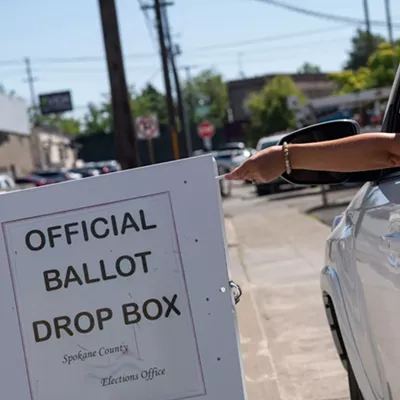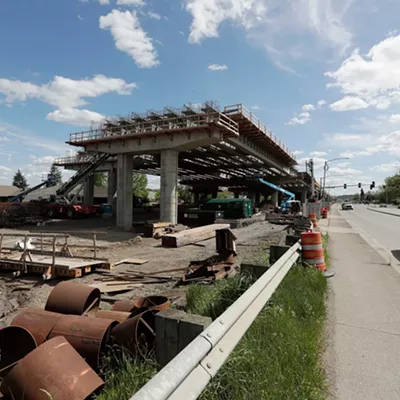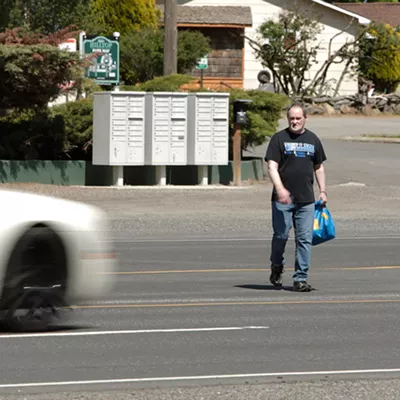There are the usual panoramic shots: things like a range of mountains against a bright winter sky, or a windswept ocean horizon with maybe some enormous boulders in the foreground. And then there are unusual panoramic shots; shots that capture a precise moment in time, whether it's a group photo from a Charlie Chaplin lookalike contest in 1921, the frozen gyrations of a 1950s roller coaster or even the first pitch going out at Safeco Field this year. These images and more comprise a fascinating photography exhibit at the Lorinda Knight gallery, through the month of January.
The show, entitled "LONG SHOTS," is guest curated by Rod Slemmons, who has 25 years of curatorial expertise (including a 14-year stint as associate curator of prints and photography at the Seattle Art Museum) and who currently teaches at the University of Washington.
"Well, a 'long shot' has two meanings, of course," laughs Slemmons, explaining the show's title. "It's a joking way to describe panoramic pictures and it also defines a high-risk proposition. What we're looking at here, of course, is a series of wide, short photographic works."
Slemmons' selection of works for this show, however, is anything but a long shot. Combining panoramic photography from the early decades of the century with contemporary art photography, Slemmons also incorporates the elements of art history, local history and a fascination with technique.
"One way to look at how panoramic photography has changed is to remember that when you see a long row of guys in a picture, like a lot of those old military photos, that it was often a circle of guys, and the camera would swing around on its tripod to take the picture," he says.
An amusing example of this is seen in a group shot of many young Charlie Chaplins, taken by Wilber Sandison, a longtime Bellingham photographer who chronicled the early days of Whatcom County with his shots of architecture, theaters, storefronts and city sidewalks.
Spokane's early history is also well-represented in the show, with a sampling of work by Charles Libby, Sr. Slemmons worked closely with the then-Cheney Cowles Museum (now the MAC) archiving Libby's photographs and he hand-selected some of the most interesting.
"We've got one he took of those great big mule harvesting teams out on the Palouse," he says. "And there's one of Nat Park, they had a roller coaster there called the Jack Rabbit that he photographed. There's a shot of Manito Park and a shot of Spokane from the top of the South Hill where you can see straight up North Division. You see a lot of downtown; you can see the Davenport and all the factories along the river."
Contemporary photography is a big part of the show as well. In addition to the aforementioned 210-degree shot of the first pitch being thrown out at Safeco Field in Seattle, "Long Shots" also showcases the work of Idaho photographer Jan Boles.
"What Jan Boles does is very interesting. Where a lot of these are just one picture, one shot, he takes four or five pictures and puts them side by side, in essence replicating peripheral vision," says Slemmons.
Visitors to the show will walk away with a sense not only of the possibilities inherent in panoramic photography but also with a sense of the technique and tools necessary to get there.
"Those long military photographs were often taken by a Kodak Cirkut Kit camera. The camera turned one way on a clockwork mechanism on top of the tripod, while the film went through the camera in the opposite direction," he says. "You had to be careful with those. If the photographer didn't stoop down, you'd often get his head in the picture."
The exhibit "Long Shots" runs Jan. 4-26 at the Lorinda Knight Gallery, 523 W. Sprague. An artist reception for Jan Boles is at 6 pm, Friday, Jan. 4. A gallery talk is at 11 am, Saturday, Jan. 5. Call: 838-3740.
Painting in the Palouse
Although GAYLEN HANSEN lives near the grain elevators, rolling farmland and small-town charms of the Palouse, it's not often that such pastoral imagery emerges in his work. The former WSU professor of art prefers instead to paint a whimsical, slightly surreal, alternate universe, peopled by enormous cats, lanky wolves and grasshoppers that go head to head with rush hour traffic.
Hansen was recently awarded a $25,000 grant by the prestigious Flintridge Foundation, which annually awards 12 such grants to mature artists from Washington, Oregon and California. The goal of the awards is to encourage older artists to continue working; for many it's a chance to explore avenues not previously available in their artistic lives.
Hansen, now in his 80s, retired from WSU in 1992, and since then his work has taken on a wild new bent. Nature and civilization are uneasy bedfellows in his work, with often comic results. "Much in this world is upside down," he writes in his artist's statement. "When you turn things upside down, you also know what is right side up."
Gaylen Hansen's work can be seen at the Flintridge Foundation Web site, www.flintridgefoundation.org.
Instant Gallery
Sometimes one of the most difficult things about working as a local artist is finding a place to show your art. While Spokane has its share of galleries, sometimes it takes months, even years to have your work selected for exhibition. Fortunately, there are empty storefronts scattered throughout the downtown corridor that are perfect for use as temporary gallery spaces. It's a win/win situation, for both building owner and artist alike.
One such space is on the lower level of the Flour Mill, where the Art for Design group has installed their current show, "LANDSCRAPES," in an empty space that once housed a bookstore, a Christmas ornament shop and a model train retailer.
"It's been pretty successful," says Denise Bowles of the Art for Design group, whose show currently inhabits the space. "[The Flour Mill management] likes it so much we've scheduled shows in there through February."
"LandScrapes" is true to its name, being a collection of various landscapes, in many cases rendered with found objects and materials, literally scraped up from beaches, driveways and fields. Participating in the exhibit are Melissa Cole, PJay McConnell, Sami Perry, Darrell Sullens, Denise Bowles, Marty Johnson and Lisa Maddux. The art includes both two-dimensional (including Marty Johnson's tiny pastel landscapes framed in vast white canvases) and three-dimensional pieces, ranging from a hilarious ceramic "alligator bag" to a length of barnwood sprouting shards of broken pottery "learning experiences."
"I used to teach pottery," explains artist PJay McConnell. "And I saved all this stuff from my students, all these pieces that broke or didn't work out. They would say, 'Why do you want to save that?' but I think it makes an interesting piece."
"LandScrapes" runs at the Flour Mill, lower level, through Jan. 5. Call: 879 -6560.
















